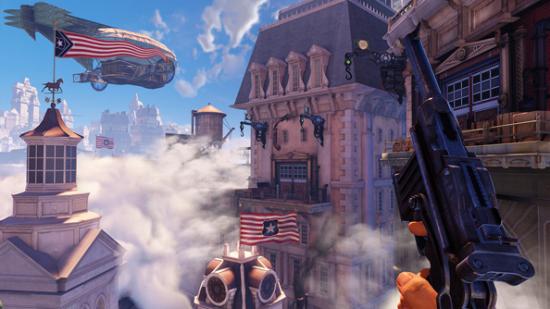BioShock Infinite is a game about a flying city and a lady who can do really good magic tricks. We’ve been playing it, partaking in its heady mix of turn-of-the-century technology, hyperactive combat and quantum-punk science-fiction.
The game is on course to become Irrational’s freshest masterpiece, being every bit as artistically original and mechanically complex as the original game, while promising one of the most compelling locations gaming’s yet seen. It’s hot stuff.
I sat down with Shawn Elliott, level designer at Irrational, to discuss in some depth the decisions behind the design choices he and Irrational have made in developing a new BioShock. I say ‘discuss’, what actually happens when you talk to Shawn Elliott is you ask him a question about game design and he talks forever. Thank goodness the man knows what he’s on about.
PCGamesN: The latest BioShock Infinitepresentation shows off battles in these giant combat arenas, are there many instances like that? Where it’s just the player versus a bunch of enemies? Combat seems to be a lot more about open spaces this time.
Shawn Elliott:There are several encounters like that in the game, some of them are larger and bolder than what you saw. That particular encounter is later in the game in a level called Emporia, and it’s at a point when there’s a full on civil war happening in Columbia. The Vox Populi are at the throats of the Founders, that’s what’s happening when you first step into that encounter. You see the defending Founders are out on the decks while the Vox raiding parties are coming in on the barges.The Handyman character jumping about, he’s a Founder. The Founders are making their last stand in that section of the city, they’reon the defensive right up until the Handyman shows up. You’re sort of a third party.
Some of the thinking behind that encounterwas thatwe wanted to create a space that really brought our systems together, an encounter that uses the skylines andbrings the Handyman into the game. So there’s any number of ways to play, there’s a lot of moving and repositioning. When you have a large space one thing you’ll see is that there are people who naturally are curious and want to go to every single bit of that space.They see that they can jump somewhere, so they jump. Then there are other people who prefer a more studied and slow approach, and they’ll only move around that space after everything’s done and everything’s dead, just to collect resources.
So without forcing people to play the way I want them to, we canstill sort of nudge them into playing a little bit outside their comfort zone and seeing things from a different light. We do that with theHandyman, who is aggressive and will pursue you in a way that is going to make you want to relocate. Whether that’s defensively or offensively is up to you, I mean if you’re turtling he’s going to make you relocate defensively. So you can go and pick another area of the mapthat you want to defend. You can go up on the balconies and lay a bunch of traps, basically wait for him to come to you, mess him up a bit, boom, relocate again and set up camp elsewhere.
Or if you want you can be far more aggressive, you can go after all those guys, take their weapons from them and use them against the Handyman, or lead him into them by jumping on to the ships they’re on. You can completely go up there and basically lure him into beating them, he’ll start doing things like throwing them at you, it’s really cool.
So I think the big theme there for me is finding a space that allows for these different play styles but encourages everyone to move in way or another, so in that way you fight using the space, if not in its entirely then something closer to it than just entering the space, wiping out every enemy and then advancing through this graveyard of corpses when you’re done.
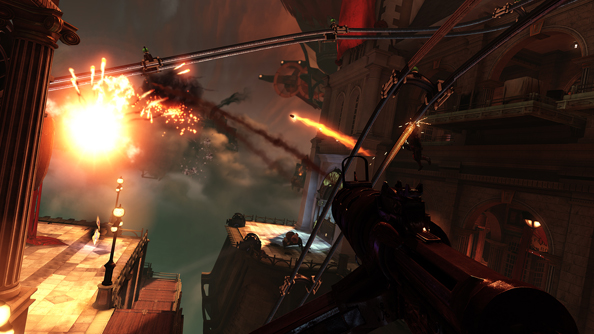
PCGN: Is it difficult to account for both kinds of players when designing these large combat arenas?
SE: Absolutely, butyou start to develop an intuitive sense when you do it. For the most part you never know until you watch people play, you have to set people down and watch what they do. Part of that’s the fun thing, I play for edge cases, I try to break things, I can’t help myself. The most delightful thing is when I think I’m being a smartass and I try to break the game, but then the system or the design responds to me in some way. I get really excited and think, that’s great, whoever made this has imagined a world in which I would be playing it.
So I’ll have responsive stuff all the time. One example is, if you start to get really aggressive and jump on those barges the Handyman will be after you immediately, he’ll want to get on there with youbecause you’re basically signalling to the game that you’re comfortable in this space, thatyou don’t need to be spoon fed. You’re saying”I’m being aggressive so go ahead and meet that with more aggression”.
I have an example in a different part of the game. I figured out the player can move to a certain place during a siege, a strictly superior tactical space, at least at first. When I discovered that during the design process, when I saw people doing it, I looked at the space and saw there were all these windows behind it. I thought ‘well what if I bring in another wave right through there’. Not that it’s a cheap shot, you’ll see it coming, but suddenly this space that you’ve enjoyed tactical superiority in for some time will suddenly shift and force you to rethink.
A lot of people will find those opportunistic locationsand think ‘I can handle everything from this one spot’, and they’ll just do that even though they know it’s probably not as fun as any number of other ways of playing. So it’s just a way to nudge people into different behaviours.
PCGN: It’s the level designer’s idea of fun versus the player’s idea, right?
SE: Well it’s important that I emphasise that it’s not a matter of making the player adhere to my prescribed playthrough, I never want to do that. I think that’s fairly horrible. But it’s a matter of being aware of the ways in which people might play, and having some sort of form of reaction to that range of play styles. I hate when you’re playing a game and it’s clear that the designer wants you to do one thing in particular, and sometimes I suspect that… well, let me put it terms of what I do, it would certainly be easier to just kill somebody for doing something that I don’t feel shows my work in the best possible light. I never want to cop out and say ‘I don’t want you to do this’. If you figured something out, it’s my job to make sure things keep going.
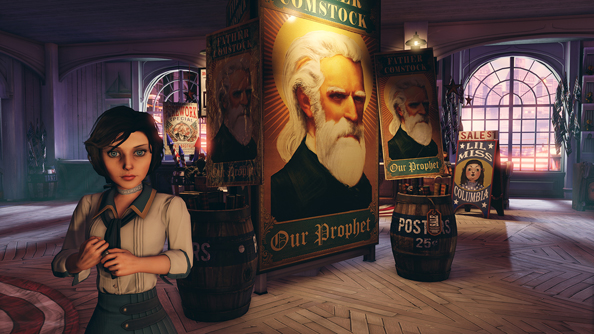
PCGN: I’d assumed that Columbia would be mostly empty by the time the player arrived, but there are loads ofNPCs milling around, living normally, at least during the first few hours of the game.It felt like I’d heard and saw a lot without trying to explore, is there a lot moreof this incidental detail to find?
SE: I would imagine so. I was walking around looking at people playing and saw that there are whole areas that never got noticed, which is completely fine, that’s part of the fun when you have those anecdote exchanges after playing. We’re absolutely fine with that, we want it to be so thatthe more you probe the more you’ll get out of it. I’d guess that there’s probably a good deal of stuff that you didn’t have the time to look at.
PCGN: Do you cater to players with the compulsion to search every inch of a level, ensuring they don’t miss anything?
SE: You don’t really need to cater to the ones who don’t feel the need to explore every single crevice, because they’ll just do what they’re going to do. It’s stillsatisfying to have that sense that there’s a whole set of unexplored shops over on the right. When catering for people who like that sort of thing however, you load this space with as manyopportunitiesas you can to support the story that you’re telling.Here’s one example, in the area before you ride the gondola to the Hall of Heroes there’s a complex of shops on the right with two storeys,similarlyon the left there’s a restaurant with itskitchen and its restrooms with a secret basement —imagine aspeakeasyor something where they have a secret door —and you’d get in and there’s this whole other space with its own story.
PCGN: One of the few criticisms levelled atBioShock was for its forced escort mission.Now you have an ally in Elizabeth for the entire game, how do you stop her being a burden on the player?
SE: We go in the opposite direction and make her an asset to you in every way that we can. When you think of an escort you think of something you need to protect, and if you’re negligent in that duty the simulation is going to come to an end, you’ll see game over and have to do it again. That never happens in this game, we’ll never impose circumstances in which you need to protect Liz or face the consequences of restarting or dying or something like that.
Another direction in which we’ve gone is that she gives you health when you need it most. The way the system works is,obviouslyshe’s not going to give you health every time you need it, but she’s definitely looking for the right opportunities pacing-wise to gives you these items when you feel like you need them the most. Bam, there she is with some ammo to keep you back in the game. So I think it’shardto feel annoyed with somebody who’s helping you survive in that fashion.
Then once you get to the tears she’s just naturally useful,especially as they start to open up and you’re presented with several different options at a time. In that encounter in the presentation alone there are about eleven tears that you can use. She’ll save your skin time and time again with those.
PCGN: Is her position in the levelimportant, are you ever waiting on her?
SE: She’ll follow you around. In combat she’s not going to be in your face but you don’t have to wait for her to get to you, so say if you’re up on a balcony and she’s down below and just in the process of jumping on a skyline to move to a position that’s closer to you, it doesn’t matter, if you ask her to open a tear she’ll open a tear.
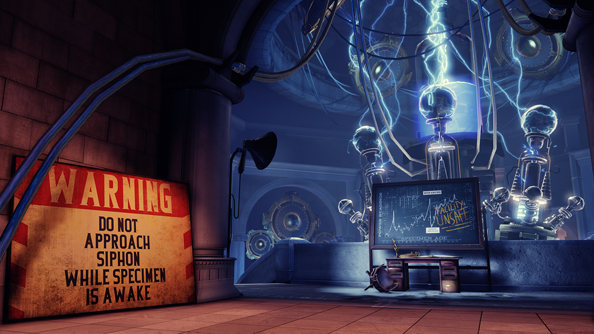
PCGN: How far reaching are the consequences of some of the decisions you make in the game? There was one encounter in which I was goaded to throw a baseball at an innocent couple, which I did. What would happen if I hadn’t?
SE: That’s definitely the kind of question where I want to leave for players to discover over time. I don’t want to go into too much detail about it. But to answer your specific questionI can say that, the players that spared the couple encountered that couple again later on and received some benefit from that. But then there’s also the opposite side of the coin. Unfortunately in the scope of this demo you don’t run into another of the figures involved in that scene yet, but they’ll come back.
PCGN: It it a challenge to create visual variety in the game, when all of BioShock Infinite is set under a blue sky on a floating city?
SE: So there are a number of options. You’ll see weather can change (and of coursethere’s still day and night), you’ll see tonal differences between the interiors, such asthe Hall of Heroes. Time progresses on Boardwalk too, actually.By the time you finish that level it’s night time. Earlier you land on the beach around sunset, and time changes in the course of that level. That’s one way to do it.
Another is just down to the artists. There’s this great moment when you first encounter the Order of the Raven guys where you turn around a corner to face their buildingand the entire mood just shifts as you start to approach it. Once you go inside it’s dark and mahogany and red, a different palette to the outside, but there’s actually a lighting change as you start to move towards that building. Your sense of atmosphere should begin to change as your approach it.
And sometimes it’s not even visual, I mean hopefully you had this odd moment when you’re looking at those kids playing hopscotch. Some are them are smoking cigarettes, maybe you think that’s a bit weird, maybe not, and then suddenly you’re in the raffle scene. It’s not horrifying like Freddie Kruger horrifying, but it should be morally horrifying in some way.
PCGN: You’ve called your magic powers ‘Vigors’ this time around, is it difficult to continue tojustify thesupernatural in the BioShock universe?
SE: I don’t think so. We never call it magic in BioShock, we always try to ground it in some of the science of the time. I don’t mean literal science of course, you couldn’t take Vigors to a physicist or a biologist right now and have him say “oh yeah, this could work”. But in the BioShock’s setting, the people in this world are experiencing these powers as a science, and not a matter of magic. So that’s very much part of the scene that we’re setting, where America’s seems to be the birthplace of all of these phenomenal inventions: telephone, flight, applications of electricity — and now they’ve got this flying city, and the ability to mesmerise machines that they’ve built. It still feels like part of that scientificmovement. I mean, look at some of the inventions that were appearing at the time in such short order, it’s easy to take for granted now, but just consider photography and cinema, all these things were mindblowing. They effectively seemed like magic at the time.
PCGN: It’s sort ofa Jules Verne futurism thing, right?
SE: Yeah, that’s definitely another influence, we look at what futurists thought at the time. Again, you never want to copy anything, but there’s some remarkable stuff to be found. If you asked a citizen in 1912 what 1999 would look like, their predictionswere a lot farther along than the reality of today. They imagined us enjoying life on Mars with aliens and stuff like that.
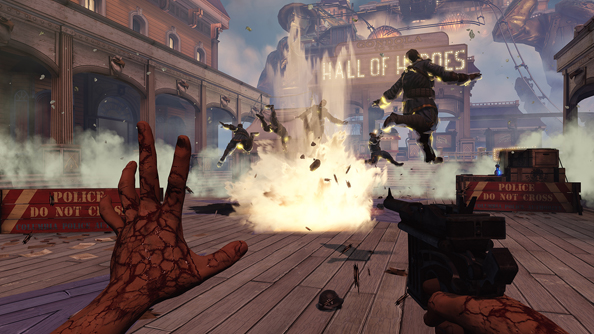
PCGN: Tell us about the PC version, how well looked after is it?
SE: We’ve taken great pains to listen to our fans and what matters most to them. So stuff like themouse acceleration and wide-screen formatting issues in the original game, we’re making sure these aren’t issues this time around. You can change the FOV whenever you like, and there’s other customisability stuff that goes for consoles as well, such as the health bars and the on-screen floating combat text, which basically tells you the amount of damage you’re doing to someone, or when they’re vulnerable to a certain thing.
PCGN: Is that thing you said on by default?
SE: Right now, yes, Ithink it is. The thinking is that if the floating combat text ison by default you’ll see it, and you can turn it off if you don’t like it. But if it’s off by default it’ll be buried in a menu and you might never know it exists. With it turned on, you’ll see as you progress that certain enemies have armour, or they’re less susceptible to damage from certain powers. For example, hitting the crows guy with crows won’t do as much damage to him as it would to someone else, so what that on-screen text will do is feedback that combat information. It’s for people who prefer that sort of thing, people into Borderlands or something, they’ll get that direct concrete feedback.
Ultimately it’s really about letting people play the way they want to. I’m a PC gamer myself, I wrote for a PC gaming magazine before I joined this studio, and I’m really excited about what we’re doing for the PC.
PCGN: Thanks for your time, Shawn.
